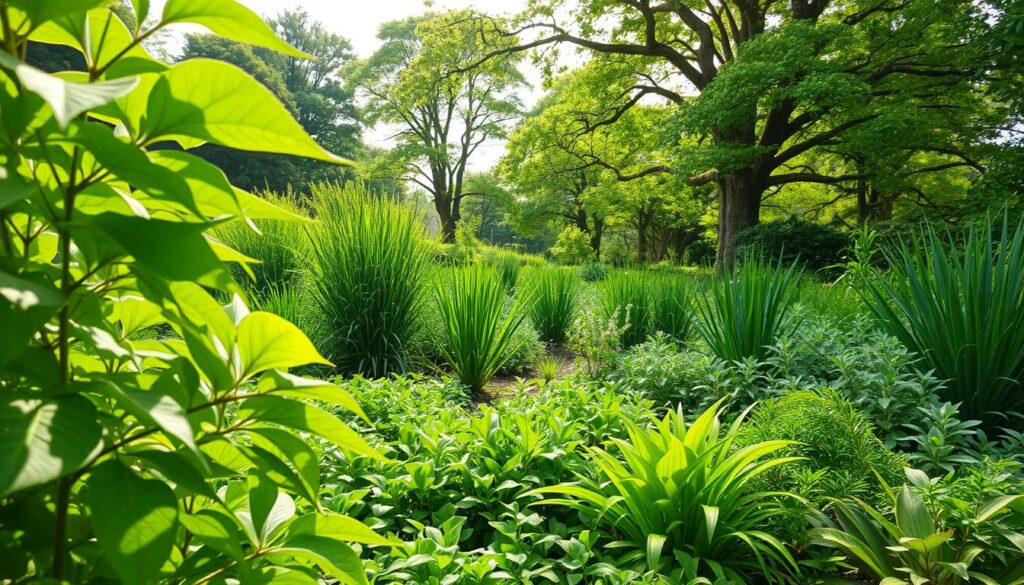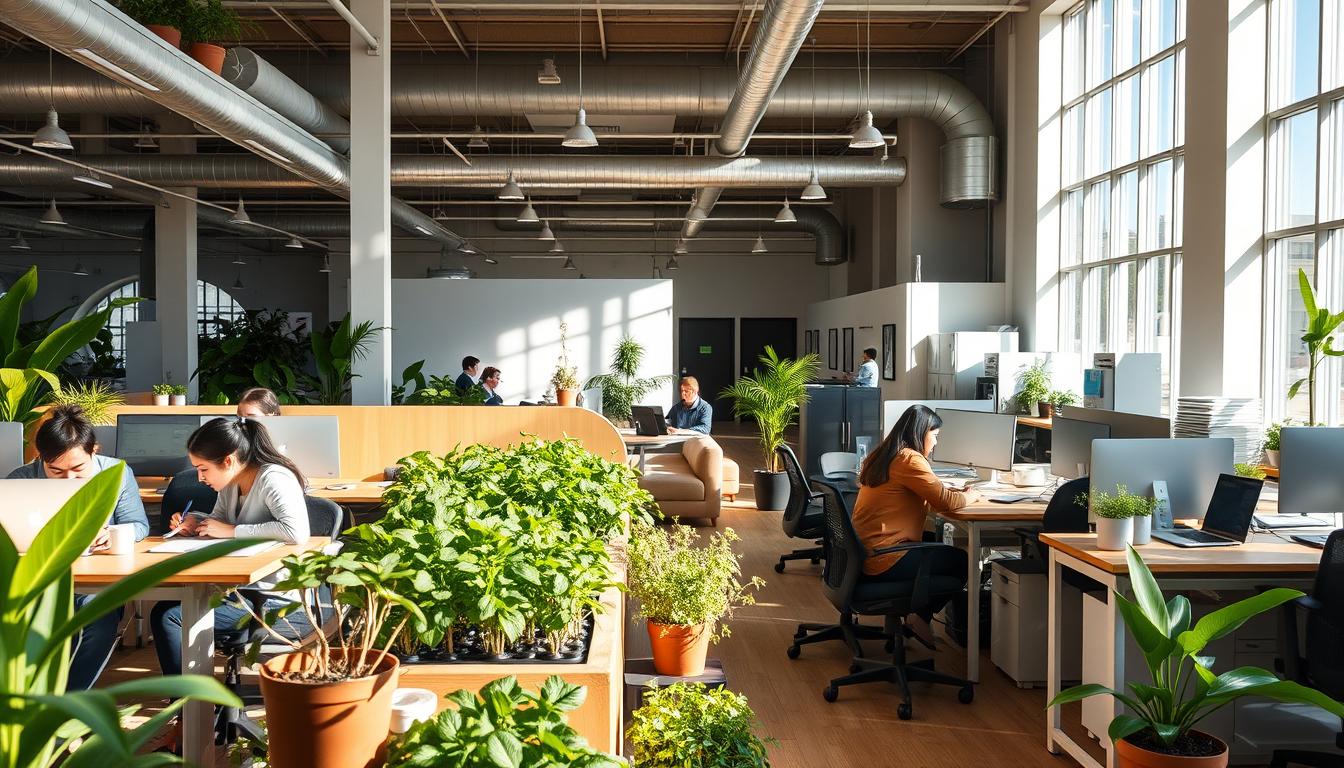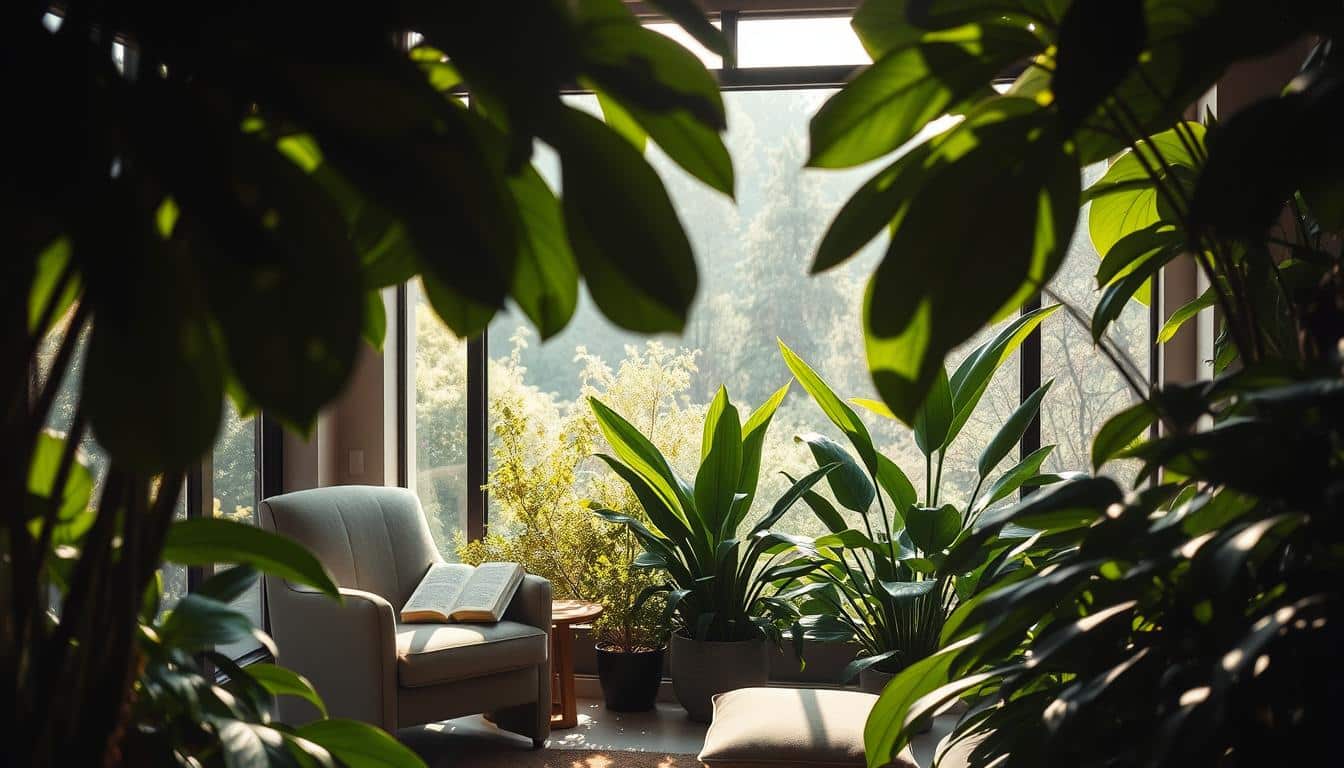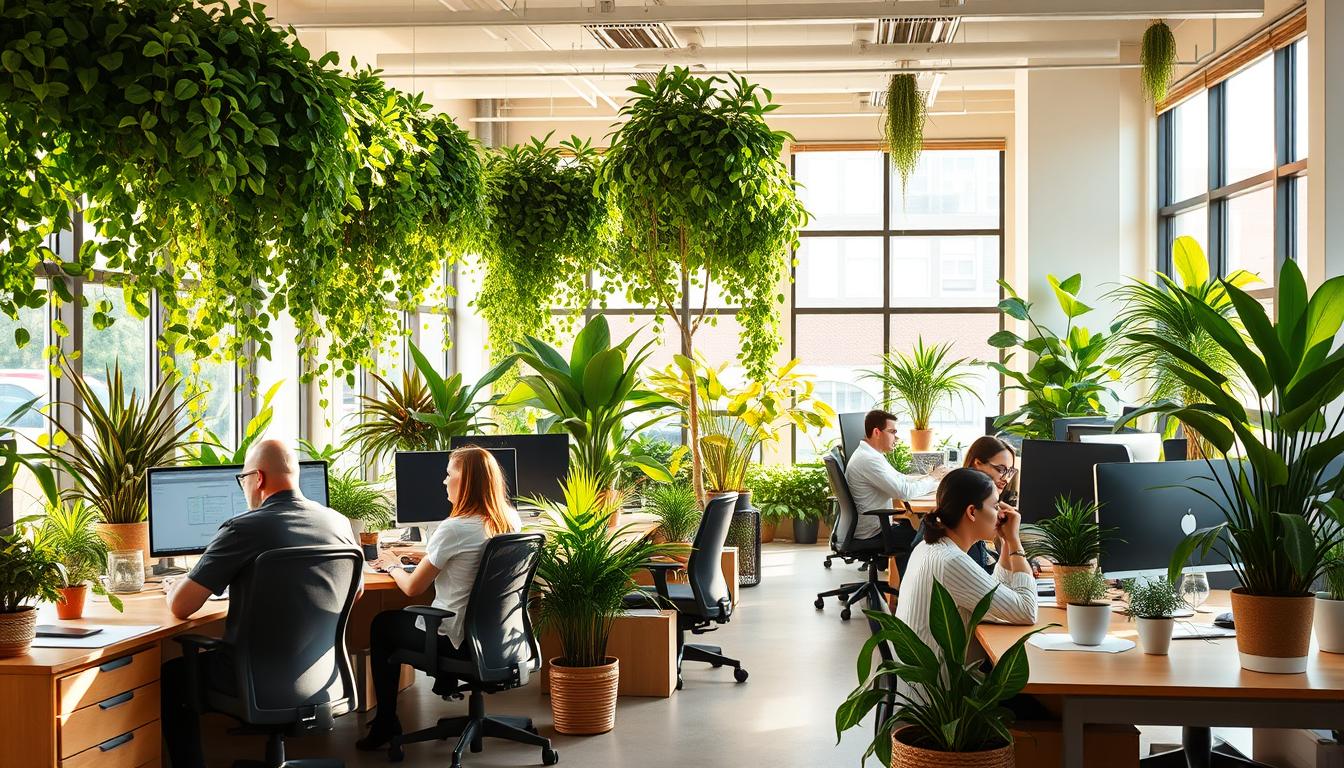Placing foliage effectively is key to a balanced garden climate. Gardeners can boost biodiversity and beauty by using eco-friendly methods. Plants placed just right help control the garden’s microclimate. They also make the garden healthier. We’ll discuss how to combine these ecological gains with good looks in this section.
The Importance of Foliage in Gardening
Foliage is key in gardening for beauty and helping the environment. Using eco-friendly gardening choices improves the environment. Plants clean the air by taking in carbon dioxide and releasing oxygen.
Diverse plant foliage helps local wildlife by giving them homes, increasing biodiversity. Understanding this can make us value nature’s beauty more.
Understanding Eco-friendliness
The connection between foliage and being eco-friendly gets stronger when we think about garden benefits. Choosing native or plants that don’t need much water saves it. It also reduces the need for harmful chemicals.
This makes a healthier place for everything to live, as chemicals can hurt our waterways. Eco-friendly gardening shows how important plants are for a sustainable future.
Enhancing Aesthetic Appeal through Foliage
Plants also make gardens look better. Using different leaf colors, shapes, and textures adds interest. This beauty makes people feel calm and happy.
Smartly arranged plants draw attention to garden highlights, making everything look united. Gardeners can mix beauty with caring for the earth. This makes a garden that’s lovely and good for the planet.

Choosing the Right Plants for Your Climate
Choosing the right plants for your garden makes it lively and healthy. It all starts with knowing your local climate. This involves a little research. It’s key to find plants that grow well in your specific weather conditions. Doing so sets your garden up for success.
Researching Plant Varieties Based on Local Conditions
Knowing your area’s climate is the first step in picking the right plants. The temperature, rain, and seasons in your region matter. Gardeners should look into:
- Temperature ranges throughout the year
- Humidity levels
- Common weather patterns in each season
Matching these details with careful research helps pick the perfect plants for your garden.
Factors to Consider: Soil, Sunlight, and Drainage
Soil type, sunlight, and water drainage are also important. Plants need different soil types to grow well. Gardeners should test their soil’s type. Sun is also crucial. It helps to know if plants need full sun, some shade, or lots of shade. Drainage is another thing to think about. Some plants can’t handle too much water. By considering these factors, you can grow a successful garden.
Foliage Placement for Climate Balance
To make a garden’s climate balanced, it’s important to put plants in thoughtful spots. This approach lets gardeners shape little climates in their gardens. These changes can better control temperature and humidity. Plus, putting the right plants together can protect certain areas, making the whole garden’s climate nicer.
Creating Microclimates in Your Garden
Microclimates are unique spots in your garden with their own climate. You can design them to fit the needs of different plants. For example, tall plants can block wind for smaller ones, and lots of leaves can keep the ground cool and moist. Elements like:
- Windbreaks with tall shrubs or trees
- Shade from larger canopies for heat-sensitive plants
- Moisture-retaining ground cover to promote a humid atmosphere
By doing this, you can manage your garden’s climate better. This helps your plants grow stronger and healthier.
Using Foliage to Manage Temperature and Humidity
Plants are key for controlling temperature and humidity. They release moisture, cooling their surroundings. By placing plants wisely, you can adjust humidity and temperature. Keep these points in mind:
- Group plants with the same water needs to keep moisture.
- Use trees or shrubs for shade to lessen heat in certain spots.
- Different leaf shapes and sizes help create varied climates.
Using plants to control garden climate helps plants thrive. It also makes the garden look good and work well.
Design Principles for Effective Foliage Layout
It’s important to know garden design principles for a beautiful, functional garden. Effective foliage layout requires understanding concepts like the Law of Significant Enclosure, the regulating line, and the Golden Ratio. These ideas help organize the space in your garden well.
The Law of Significant Enclosure
This rule is all about balancing plant height with the space around them. By choosing plant sizes thoughtfully, your garden feels united. The Law of Significant Enclosure suggests that good borders make a garden welcoming. It makes plants and pathways blend smoothly together.
Implementing the Regulating Line Concept
The regulating line helps organize your garden design. It makes the layout orderly by leading the viewer’s eye. Aligning plants with this line connects different garden parts well. This method improves your garden’s look.
Applying the Golden Ratio in Plant Placement
The Golden Ratio guides plant placement for beauty and balance. Using this principle, your plant arrangement will look good and feel right. The Golden Ratio makes your garden eye-catching and peaceful.
Creating Visual Impact with Height
Plant heights are key in making a garden catch the eye. Setting up a clear rank of plant heights helps use space well, making the garden look more organized. Designing your garden with layers keeps it interesting all year round.
Establishing a Hierarchical Plant Structure
Start by placing tall plants in the back and short ones in front. This layout creates a garden depth, making sure you can see every plant. It brings a sense of order and beauty to your garden.
Maximizing Space with Plant Heights
Choosing plants of different heights helps use space wisely. This technique allows for more plant variety and keeps the garden lively. Different plant levels not only look good but also let sunlight reach every plant, keeping them healthy.
Utilizing Color and Texture for Aesthetic Pleasures
Using color and texture well can make gardens look better. By using the color wheel, gardeners can find colors that look good together. This makes the garden more appealing.
Exploring the Color Wheel in Plant Choices
The color wheel helps gardeners make their gardens look great. It helps in choosing plants that go well together and stand out. This makes the garden colors rich and keeps it interesting all year.
Mixing Foliage Textures for Visual Interest
Adding different textures to plant leaves makes gardens more interesting. Using a mix of textures keeps people looking at the garden. This, with good color choices, makes the garden a pleasure to see and experience.
Planting Strategies for Garden Cohesion
Effective planting can really bring a garden together, improving its look and use. Using mass planting and timing blooms carefully, you can make your garden pop. Planting in groups gives your garden a unified look and makes upkeep easier. This keeps your garden looking good all year round.
Mass Planting for Greater Impact
Mass planting means putting lots of the same plant together. It makes a big visual splash. This method adds life and movement to your garden. It makes your garden look full and lively, grabbing attention. Plus, it makes taking care of plants easier, like watering and feeding, making your garden easier to manage.
Staggering Bloom Times for Continuous Color
Having plants bloom at different times keeps your garden colorful all season. By staggering when plants bloom, your garden always has something pretty to show. Mix and match plants that bloom at different times. This approach keeps your garden interesting. It brings a steady flow of color, adding to your garden’s appeal.
The Role of Hardscaping in Foliage Design
Adding hardscaping to your garden design boosts its beauty and usefulness. It involves non-plant elements that have both practical and decorative uses. Features like pathways, patios, and retaining walls not just guide movement, but also add contrast, making the plants stand out more.
Integrating Non-Plant Elements
Putting non-plant features into your garden adds structure and meaning. Let’s look at the benefits of hardscaping:
- Creates clear paths through the garden.
- Stabilizes soil and plants, cutting down on erosion.
- Makes the space more usable by adding spots for gatherings or seating.
These components help balance the natural elements and give your garden a unified look.
Creating Focal Points with Hardscape
Hardscaping can guide your eyes to key spots in the garden, creating focal points. Consider using:
- Decorative stone walls around flower beds.
- Benches or sculptures for exploration and rest.
- Water features that draw the eye and soothe the mind.
By carefully choosing and placing these elements, you create a visual story. This story emphasizes and enriches the greenery.
Conclusion
Choosing the right plants for your garden is key for a climate-friendly yard. It’s not just about looks; picking and arranging plants wisely supports nature too. Knowing your garden’s soil and sunlight helps you create areas perfect for many plants.
Adding things like walkways, walls, and outdoor furniture makes your garden look and work better. These features, along with plants, make your garden inviting. So, it’s important to think about both plants and design for a great outdoor space.
Learning about garden plants makes your gardening more rewarding and helps you connect with nature. By using these tips, your garden will not only be a joy for you but also good for the planet.



